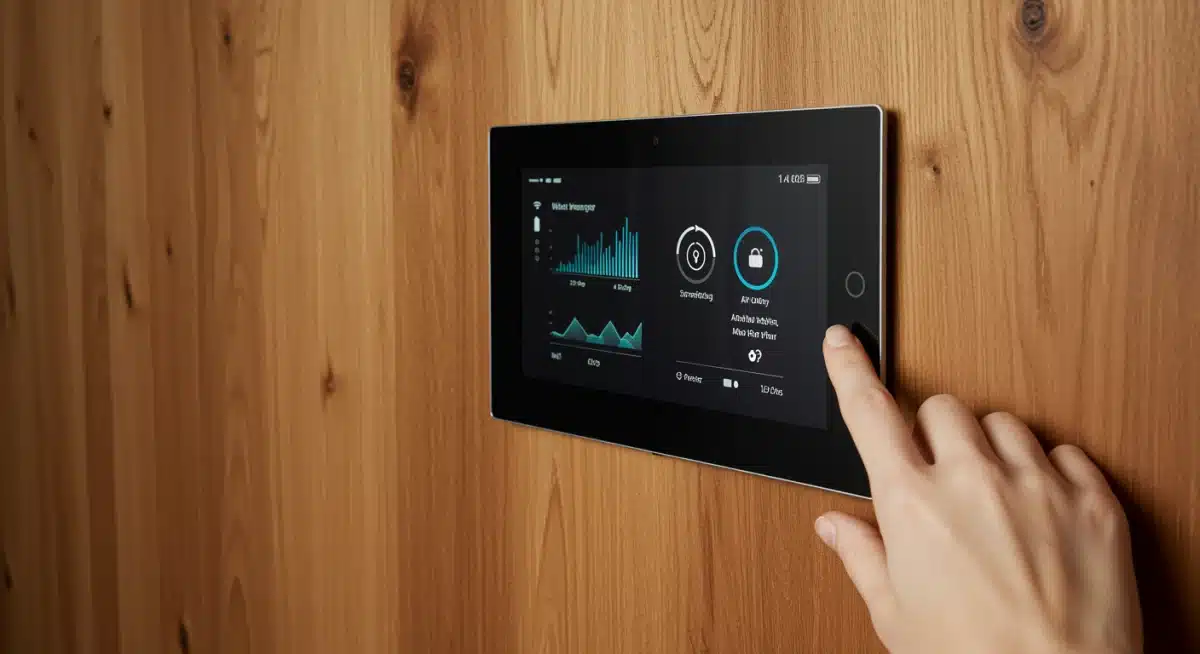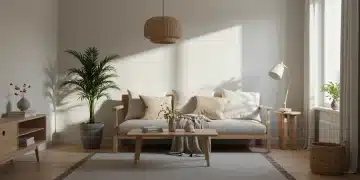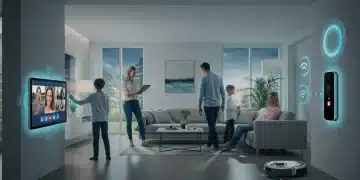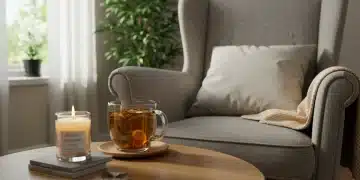Home as a Sanctuary: 6 Design Trends for Serenity in 2025

As of early 2024, emerging lifestyle trends indicate a significant shift towards creating a home as a sanctuary, with six key design trends for 2025 focusing on tranquility, well-being, and a deep connection to nature.
In a world increasingly characterized by constant connectivity and external stressors, the concept of a home as a sanctuary is not just a luxury but a growing necessity. As we look towards 2025, design trends are rapidly evolving to prioritize tranquility, well-being, and a profound connection to nature within our living spaces. This shift reflects a collective desire for environments that nurture peace and offer respite from the demands of modern life.
Biophilic Design: Bringing Nature Indoors
Biophilic design, which integrates natural elements into built environments, continues to gain momentum as a foundational principle for creating a home as a sanctuary. This trend recognizes the innate human connection to nature and aims to foster a sense of peace and well-being by blurring the lines between indoor and outdoor spaces. The emphasis is on natural light, ventilation, and the presence of living organisms.
Leading architects and interior designers are incorporating large windows, skylights, and even internal courtyards to maximize natural light and views of greenery. The strategic placement of indoor plants, living walls, and water features transforms sterile environments into vibrant, calming ecosystems. This approach is not merely aesthetic; studies confirm that exposure to natural elements can reduce stress, improve cognitive function, and enhance overall mood.
Key Elements of Biophilic Integration
Achieving a truly biophilic sanctuary involves more than just adding a few potted plants. It requires a holistic consideration of how natural patterns, forms, and processes can be woven into the fabric of the home. This includes thoughtful material selection and sensory experiences.
- Natural Materials: Utilizing wood, stone, bamboo, and cork not only adds textural richness but also connects inhabitants to the earth.
- Organic Shapes: Incorporating furniture and architectural features with soft, curved lines mimics forms found in nature, promoting a sense of fluidity and calm.
- Sensory Engagement: Designing for natural sounds like trickling water, gentle breezes, and even the scent of fresh earth or essential oils further enhances the biophilic experience.
Mindful Minimalism: Decluttering for Clarity
Mindful minimalism is emerging as a cornerstone for those seeking a home as a sanctuary in 2025. This trend moves beyond mere aesthetic simplicity, focusing instead on intentional living through thoughtful curation of possessions. The goal is to create spaces that are free from visual clutter, allowing for mental clarity and a sense of calm.
This approach advocates for quality over quantity, encouraging homeowners to invest in durable, meaningful items that serve a purpose and bring joy. Storage solutions are paramount, designed to be integrated and discreet, ensuring that everyday items are easily accessible yet out of sight. The philosophy behind mindful minimalism is that a decluttered physical space leads to a decluttered mind, fostering an environment conducive to relaxation and introspection.
Principles of Intentional Living Spaces
Implementing mindful minimalism effectively requires a shift in perspective, moving away from consumerism towards conscious choices. It’s about creating a personal retreat where every item has a place and a purpose, contributing to the overall sense of peace.
- Purposeful Furnishings: Each piece of furniture is chosen for its function, comfort, and aesthetic value, avoiding superfluous items.
- Neutral Color Palettes: Soft, muted tones such as whites, grays, beiges, and earthy greens create a calming backdrop that promotes serenity.
- Strategic Storage: Built-in shelving, hidden compartments, and multi-functional furniture are key to maintaining a clean and orderly appearance.
Smart Wellness Technology: Seamless Integration for Well-being
The integration of smart wellness technology is redefining the concept of a home as a sanctuary for 2025. Far from being obtrusive, these technologies are designed to seamlessly enhance comfort, health, and peace of mind. From intelligent lighting systems that mimic natural daylight cycles to air purification systems that monitor and improve air quality, technology is becoming an invisible assistant in creating optimal living environments.
Innovations include smart thermostats that learn preferences, adjusting temperatures to promote better sleep, and sound systems that provide calming ambient noise or guided meditations. The focus is on intuitive, user-friendly interfaces that allow inhabitants to easily control their environment, tailoring it to their specific needs for relaxation and rejuvenation. This trend emphasizes that technology, when thoughtfully applied, can be a powerful tool for wellness.
Enhancing Comfort Through Innovation
The latest smart home devices are moving beyond basic automation, offering sophisticated features that actively contribute to a healthier and more serene lifestyle. These systems often work in unison, creating a harmonious and responsive living space.
- Circadian Lighting: Systems that adjust light intensity and color temperature throughout the day to support natural sleep-wake cycles.
- Advanced Air Quality Monitoring: Devices that detect pollutants, allergens, and humidity levels, automatically activating purifiers and humidifiers as needed.
- Personalized Soundscapes: Smart speakers offering a wide range of natural sounds, white noise, or guided meditation tracks to aid relaxation and focus.

Texture and Sensory Experiences: Engaging the Senses
In the pursuit of a home as a sanctuary, design trends for 2025 place significant emphasis on engaging all five senses through rich textures and carefully curated sensory experiences. Beyond visual appeal, the tactile quality of materials, the subtle scents, and even the ambient sounds within a home contribute profoundly to its overall atmosphere of tranquility. This holistic approach seeks to create spaces that feel deeply comforting and inviting.
Designers are exploring a wider range of materials, favoring those with distinct tactile properties such as rough-hewn wood, soft bouclé fabrics, smooth polished stone, and woven natural fibers. These textures add depth and interest to a space, inviting touch and creating a layered, cozy feel. Furthermore, incorporating elements like essential oil diffusers, subtle water features, and sound-absorbing materials enhances the auditory and olfactory dimensions of the home, leading to a truly immersive sanctuary experience.
Crafting a Multi-Sensory Environment
The intentional layering of textures and sensory inputs helps to create a haven that stimulates positive emotions and promotes relaxation. It’s about designing an environment that feels good to be in, not just to look at.
- Tactile Textiles: Plush rugs, velvet cushions, linen drapes, and chunky knit throws provide comfort and visual warmth.
- Aromatic Accents: Natural candles, diffusers with calming essential oils (lavender, cedarwood), and fresh flowers contribute to a pleasant olfactory experience.
- Acoustic Comfort: Using soft furnishings, thick curtains, and strategically placed rugs to absorb sound and create a quieter environment.
Personalized Retreat Zones: Spaces for Solitude
The concept of a home as a sanctuary in 2025 increasingly includes the creation of dedicated personalized retreat zones. As homes become more multi-functional, serving as offices, gyms, and entertainment hubs, the need for distinct spaces for solitude and personal reflection has become paramount. These zones are specifically designed to offer an escape, a place where individuals can recharge, focus, or simply unwind without interruption.
These retreat zones can range from a cozy reading nook tucked away in a quiet corner to a dedicated meditation room or even a private outdoor garden space. The design of these areas focuses on elements that promote individual comfort and cater to specific activities. Lighting, seating, and decor are all chosen to enhance the sense of privacy and peace, making these spaces essential for mental and emotional well-being within the home.
Designing for Individual Well-being
Creating effective retreat zones requires understanding the specific needs and preferences of the inhabitant. It’s about crafting an environment that supports personal rituals and provides a sense of peace and detachment from daily demands.
- Comfortable Seating: An ergonomic chair, a plush chaise lounge, or floor cushions designed for extended periods of relaxation or meditation.
- Controlled Lighting: Dimmable lights, task lighting, or natural light sources that can be easily adjusted to create the desired ambiance.
- Minimal Distractions: Keeping these spaces free from technology (unless specifically for meditation apps) and clutter to encourage focus and introspection.
Sustainable and Ethical Sourcing: Conscious Living
A crucial aspect of creating a home as a sanctuary in 2025 involves a deeper commitment to sustainable and ethical sourcing of materials and furnishings. Homeowners are increasingly conscious of their environmental footprint and the social impact of their purchasing decisions. This trend reflects a desire to create not only a personal haven but also a home that aligns with broader values of responsibility and respect for the planet.
This means prioritizing furniture made from recycled or rapidly renewable resources, choosing textiles produced with organic or low-impact dyes, and opting for decor from artisans who practice fair trade. The focus is on transparency in supply chains and supporting brands that demonstrate a genuine commitment to environmental stewardship and ethical labor practices. Sustainable design is no longer a niche market but a core component of creating a truly mindful and peaceful living space.
Making Eco-Conscious Choices
Integrating sustainability into home design involves a holistic approach, from the initial planning stages to the final decorative touches. It’s about making informed decisions that benefit both the environment and the inhabitants.
- Recycled and Upcycled Materials: Incorporating items made from reclaimed wood, recycled glass, or upcycled fabrics reduces waste and adds character.
- Local and Artisanal Products: Supporting local craftsmen and artisans reduces transportation emissions and often ensures higher quality, unique pieces.
- Energy-Efficient Appliances: Investing in appliances that minimize energy consumption contributes to a lower carbon footprint and reduces utility costs.
| Key Trend | Brief Description |
|---|---|
| Biophilic Design | Integrates nature indoors to boost well-being and tranquility. |
| Mindful Minimalism | Declutters spaces for mental clarity and intentional living. |
| Smart Wellness Tech | Seamlessly integrates technology for improved comfort and health. |
| Personalized Retreats | Dedicated zones for solitude, relaxation, and individual well-being. |
Frequently Asked Questions About Sanctuary Home Design
The core idea is transforming residential spaces into havens of peace, comfort, and well-being. It focuses on design choices that reduce stress, promote relaxation, and foster a deep sense of personal tranquility amidst daily life’s demands. It’s about creating a restorative environment.
Biophilic design integrates natural elements like plants, natural light, and organic forms into interiors. This connection to nature has been shown to reduce stress, improve mood, and enhance cognitive function, directly contributing to a more serene and calming home environment.
Yes, when implemented thoughtfully, smart wellness technology can greatly enhance a sanctuary. Features like circadian lighting, air quality monitoring, and personalized soundscapes create an effortlessly comfortable and healthy environment, promoting relaxation without visible tech clutter.
Mindful minimalism promotes decluttering and intentional curation of possessions. By reducing visual noise and focusing on meaningful items, it creates mental clarity and a sense of calm, which are essential components of a peaceful and restorative home sanctuary.
Sustainable and ethical sourcing aligns with conscious living, ensuring your home reflects values of environmental responsibility and social impact. Knowing your furnishings are ethically produced contributes to a deeper sense of peace and integrity within your personal sanctuary.
Looking Ahead
The emphasis on creating a home as a sanctuary is not merely a fleeting trend but a fundamental shift in how we view and utilize our living spaces. As external pressures continue to mount, the demand for environments that actively support mental and physical well-being will only intensify. Future developments are expected to further integrate advancements in sustainable technology, personalized sensory experiences, and adaptable spaces, ensuring our homes evolve into truly restorative havens. This ongoing transformation signals a future where peace and personal well-being are at the forefront of residential design.





